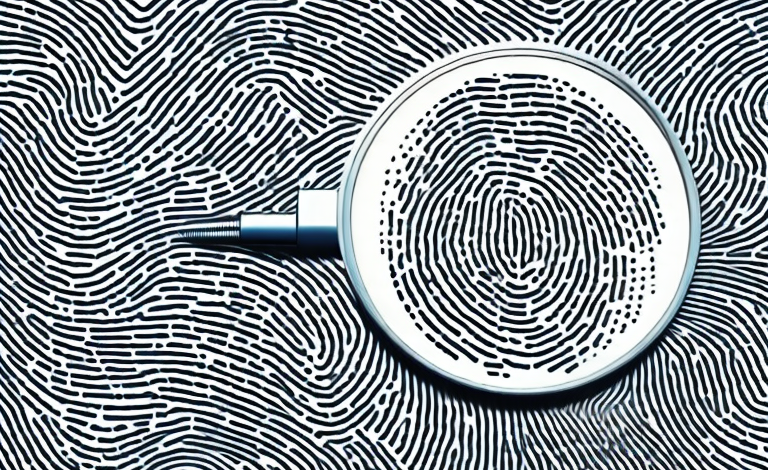Fingerprints are one of the oldest and most reliable methods of identification, used for centuries by forensic investigators to solve crimes. However, there are often concerns about whether fingerprints can be lost or changed, and what impact this may have on criminal investigations or biometric security systems. In this article, we will explore the science behind fingerprints and the different factors that can lead to changes in their appearance or detection.
The science behind fingerprints: what are they made of?
Fingerprints are essentially made up of ridges and valleys on the skin’s surface, which form unique patterns that can be analyzed for identification purposes. These patterns are created during fetal development and are believed to be influenced by a combination of genetic and environmental factors. The ridges themselves are made of a protein called keratin, which is the same substance found in hair and nails. Essentially, fingerprints are a kind of natural barcode that can be used to distinguish individuals from each other.
While fingerprints have been used for identification purposes for over a century, the science behind their analysis has evolved significantly in recent years. Today, forensic experts use a variety of techniques to analyze fingerprints, including chemical treatments, digital imaging, and computer algorithms. These methods allow for more accurate and efficient identification, which is particularly important in criminal investigations.
Interestingly, fingerprints are not unique to humans. Many other primates, as well as some other animals, also have ridges and patterns on their skin that can be used for identification. However, human fingerprints are still considered to be the most complex and distinctive, making them a valuable tool in forensic science and other fields.
The role of genetics in determining fingerprint patterns
Although the specific environmental factors that influence fingerprint patterns are not clear, it is believed that genetics are a major determinant. For example, identical twins have virtually identical fingerprints, while siblings and other closely related individuals often have similar patterns. However, even genetically identical individuals can have slight variations in their fingerprints due to random developmental processes. This means that while fingerprints can be a useful tool for identification, they are not always foolproof.
Recent studies have also shown that certain genetic mutations can lead to unique fingerprint patterns. For instance, a mutation in a gene called SMARCAD1 has been linked to the development of a rare type of fingerprint pattern known as adermatoglyphia, which is characterized by the absence of fingerprints. This highlights the complex interplay between genetics and environmental factors in determining fingerprint patterns, and the need for further research in this area.
Can fingerprints change with age or injury?
Fingerprints can be altered by a variety of factors, including age, injury, and diseases that affect the skin’s surface. For example, older individuals often have more prominent wrinkles and lines on their fingers, which can obscure or modify their fingerprint patterns. Similarly, injuries like burns or cuts can damage the skin’s surface and disrupt the ridges, potentially making it harder to identify an individual. This can be especially problematic in criminal investigations, where suspects may attempt to alter their fingerprints to avoid detection.
In addition to age and injury, there are also certain medical conditions that can affect fingerprints. For instance, individuals with eczema or psoriasis may experience changes in their fingerprint patterns due to inflammation and scarring of the skin. Additionally, certain medications or chemotherapy treatments can cause temporary or permanent changes to fingerprints. It is important for forensic experts to be aware of these potential factors when analyzing fingerprints for identification purposes.
The impact of manual labor on fingerprint patterns
Another factor that can affect fingerprint appearance is manual labor. Individuals who perform manual labor jobs that involve repeated friction or pressure on the fingers may develop distinctive ridges or calluses that can obscure or modify their natural patterns. This can be a particular problem for individuals who work in industries like construction or manufacturing, where fingerprints may be required for security or identification purposes. However, even individuals with highly modified fingerprints can often still be identified through careful analysis of their patterns.
It is important to note that manual labor is not the only factor that can affect fingerprint patterns. Other factors such as age, genetics, and injury can also alter the appearance of fingerprints. In some cases, individuals may even have no visible fingerprints at all, a condition known as adermatoglyphia.
Despite these challenges, fingerprint analysis remains a valuable tool in law enforcement and forensic investigations. Advances in technology, such as the use of digital fingerprint scanners and automated matching algorithms, have made it easier and faster to identify individuals based on their fingerprints. However, it is still important for experts to carefully examine and interpret the unique characteristics of each fingerprint to ensure accurate identification.
How to prevent temporary loss or damage to fingerprints
In some situations, individuals may experience temporary loss or damage to their fingerprints, either through injury or exposure to certain chemicals or substances. In these cases, it is important to seek medical attention and take steps to protect the fingers from further damage. For example, wearing protective gloves or using special creams or ointments can help promote healing and reduce the risk of further damage.
It is also important to avoid activities that may further damage the fingers, such as excessive exposure to water or harsh cleaning chemicals. Additionally, individuals should avoid using abrasive materials or tools that may cause further damage to the skin on the fingers.
If the loss or damage to fingerprints is permanent, individuals may need to seek alternative methods of identification, such as using other biometric data or relying on personal identification documents. It is important to consult with legal and medical professionals to determine the best course of action in these situations.
Can fingerprints be intentionally altered or erased?
In rare cases, individuals may attempt to intentionally alter or erase their fingerprints to avoid detection. In most cases, this involves using harsh chemicals or abrasive materials to damage the skin’s surface, or undergoing surgery to remove the ridges entirely. However, attempting to alter or erase fingerprints is generally not very effective, and can often cause more harm than good. In addition, it is a criminal offense to intentionally alter or destroy fingerprints or other forms of identification.
It is important to note that even if an individual is successful in altering or erasing their fingerprints, there are still other methods of identification that can be used to link them to a crime. For example, DNA evidence, surveillance footage, and eyewitness testimony can all be used to build a case against a suspect. Therefore, attempting to alter or erase fingerprints is not a foolproof method of avoiding detection or prosecution.
Biometric technology: how reliable are fingerprint scans?
With the rise of biometric technology, fingerprint scans have become an increasingly popular tool for security and identification purposes. However, there is always a risk that these scans may be subject to errors or glitches that could lead to false positives or false negatives. In addition, there are concerns about the potential for hackers or other malicious actors to bypass or manipulate biometric security systems. While fingerprint scans can be effective for many purposes, they should always be used in conjunction with other forms of identification and security measures.
One potential issue with fingerprint scans is that they may not work as well for certain individuals. For example, people who have certain medical conditions or who work in certain industries may have fingerprints that are difficult to read or that change frequently. This can make it more difficult to use fingerprint scans as a reliable form of identification.
Another concern with biometric technology is that it may be used in ways that violate people’s privacy or civil liberties. For example, some governments or companies may use biometric data to track individuals without their consent or to discriminate against certain groups of people. As biometric technology becomes more widespread, it will be important to ensure that it is used ethically and in ways that respect people’s rights and freedoms.
Legal implications of lost or changed fingerprints in criminal investigations
When it comes to criminal investigations, lost or changed fingerprints can have significant legal implications. For example, an individual accused of a crime may claim that their fingerprints were altered or damaged in some way, which could affect their guilt or innocence. Similarly, investigators may have to consider factors like age or manual labor when analyzing fingerprint evidence, and may need to take additional steps to ensure the accuracy and reliability of their results.
In some cases, the loss or alteration of fingerprints can also lead to wrongful convictions or the release of guilty individuals. For instance, if a suspect’s fingerprints are lost or damaged, investigators may rely on other forms of evidence that could be less reliable or subject to interpretation. Additionally, if a person’s fingerprints are mistakenly matched to a crime scene, they could be wrongfully accused and convicted. Therefore, it is crucial for investigators to carefully document and preserve fingerprint evidence, and to consider all possible factors that could affect its accuracy and validity.
The future of biometrics: alternative methods for identification
As technology continues to evolve, there may be new and more effective methods for identification and security that go beyond traditional fingerprints. For example, some researchers are exploring the use of facial recognition or other biometric markers that may be less prone to errors or manipulation. However, these technologies also raise new concerns about privacy, security, and potential biases or inaccuracies. As we look to the future of biometrics, it will be important to balance the potential benefits with these potential risks.
Overall, while fingerprints are a valuable and reliable tool for identification and security, they are not infallible. A variety of factors can affect their appearance or detection, and it is important for investigators and security professionals to carefully consider these factors when analyzing and interpreting fingerprint evidence. As we continue to explore new technologies and methods for biometric identification, we will need to remain vigilant to ensure the accuracy and reliability of these systems.
One potential alternative method for identification that is gaining attention is the use of behavioral biometrics. This involves analyzing patterns in an individual’s behavior, such as their typing rhythm or mouse movements, to create a unique profile that can be used for identification. While this method may be less invasive than traditional biometrics, it also raises concerns about privacy and the potential for false positives. As with any new technology, it will be important to carefully evaluate the benefits and risks before implementing behavioral biometrics on a large scale.



